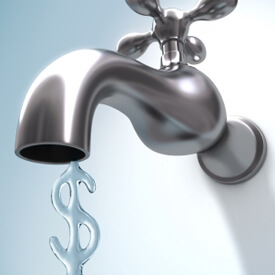
Here are some basic tips to help you save money on your water bill.
Saving Water Inside Your Home
In the home, you can save water in a variety of places. In the kitchen, you should concentrate on saving water. Always use your dishwasher in order to save money on your water bill.
Contrary to popular belief, it actually takes more water to wash dishes by hand than it does to run the dishwasher. And, when you use the dishwasher, do not pre-rinse your dishes. You should simply just scrape and put the plates inside because today’s modern dishwashers are very powerful at removing grime from your plates.
In the bathroom, you can save water and money by doing the following:
– Install a low-flow shower head to save as much as 25% of your water usage
– Take a shorter shower, and shower instead of taking baths
– Turn off the water while you’re brushing your teeth (that little bit of time adds up over the course of a month)
When doing laundry, consider the following:
– Only do laundry when the load is full Virginia
– Consider wearing items more than once – especially pants and outerwear that tend to not get as dirty
– Upgrade to a high-efficiency washing machine (and they look pretty cool too!)
For the handyman:
– Install a tankless water heater – It heats water faster and only when you need it. So, it saves both water and energy.
– Insulate your pipes with insulation to keep the hot water warm in transit
How To Save Water Outside The House
There are many ways to save water outside the house as well. The first starts with landscaping:
– Landscape with plants that do not require a lot of water, such as succulents
– Use an irrigation system, and setup the timer to water early before the sun comes out, and make sure it includes a moisture sensor to not water if it rains
– Consider sweeping your sidewalk and driveway and not hosing it off
– Wash your car less often
There are several ways that you can easily save on your water bill. You simply have to be conscientious of how you use this finite resource to ensure that you are not wasting it.
What about you? How do you save on your water bill? Did I miss a few tips or tricks? I’d love to hear about it in the comment section below.

I am fortunate to live in one of the only parts of the country unaffected by drought, but we still do things like use our low-flow shower heads and toilets, and always turn off the water when we’re brushing our teeth. It makes up for the fact that we cloth diaper our son and do a lot of laundry!
Although we enjoy abundant supply of water today, we still conserve home and garden use in respect of its lack in most parts of the world. We may be lucky today to enjoy this utility but there will come a time when we won’t always have the luxury of taking a shower or bath everyday. This early, our family is gearing up for the eventual loss or diminished supply of water.
The tankless water heater is a great idea. However, some say that it just doesn’t heat up water fast enough. Is that true?
There are countries that lacks in water supply, while there are some who has a plenty of running water inside their home. Maybe we should be mindful of them, and by conserving our resources we can provide for those who suffer from drought.
Well, I managed to save enough money when I bought a dishwasher. It consumes less water than I did while I was washing dishes =)
Planned landscaping can also reduce energy costs inside the home. Trees, shrubs and other plants that shade the building or the outdoor air conditioning unit can reduce the need to run the air conditioner, while a windbreak of trees eases cold winds in the winter so you don’t need to run the heating system as much.
When pools include water features, unique lighting, specialty materials and design features, they have powerful influence on adjacent outdoor living spaces, particularly when well illuminated by night lighting.
Before making a cut, look for the branch collar, which grows from the stem tissue at the bottom base of the branch. Look for the branch ridge, which is on the upper surface and is parallel to the branch angle at the stem.